Lava Xolo X900 Review - The First Intel Medfield Phone
by Brian Klug on April 25, 2012 6:00 AM ESTGPU Performance - GLBenchmark 2.1
While Intel's Atom core is a newcomer to Android, the PowerVR SGX 540 used in Medfield's SoC has been around the block quite a bit. Most recently, Samsung's Galaxy Nexus used an OMAP 4 that features the same SGX 540 GPU. The GPU clock is a bit higher than we're used to at 400MHz (vs 304MHz for the Galaxy Nexus), but otherwise the design and its performance are both known quantities.
We start with GLBenchmark, one of the better Android GPU tests on the market today. There are two benchmarks, Egypt and Pro, and each is run in two modes: native screen resolution and offscreen (vsync disabled) at 720p. The latter is more useful for apples to apples comparisons as everything is rendering the same number of pixels, whereas performance in the onscreen tests is determined by the screen resolution of the device along with the performance of its GPU.
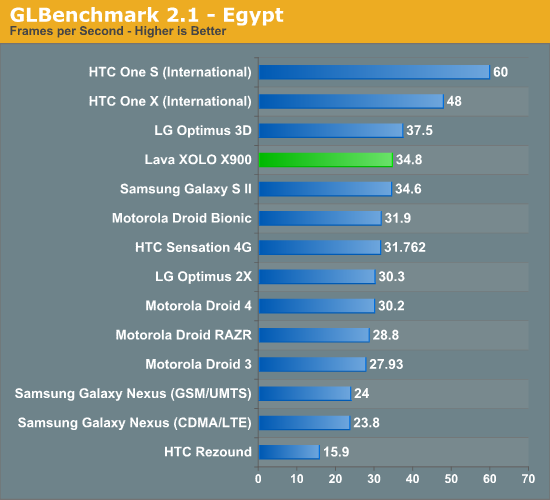
The X900 falls in just behind the Optimus 3D, which shares the same GPU but is running at a lower resolution. All things considered, the X900 does reasonably well here but it's definitely not leading the pack.
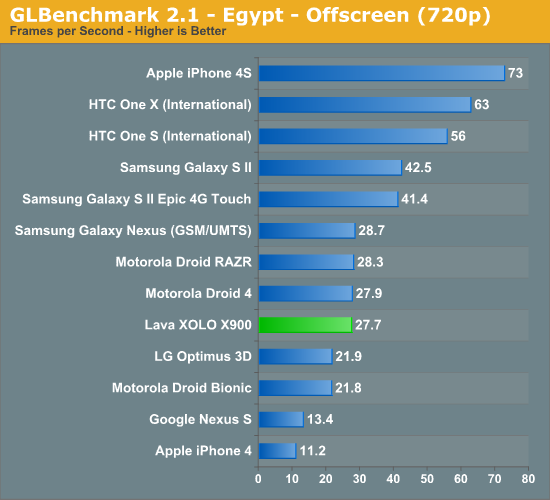
At the same display resolution and without any vsync limits, the X900 falls significantly behind the cream of the crop. Despite the GPU clock advantage, Medfield is no faster than OMAP 4 in the Galaxy Nexus here which is a bit perplexing. We're either bumping into a memory bandwidth limit or some other CPU/driver limitation. Either way, Intel definitely needs a faster GPU. We'll get it but not until early next year with the 544MP2 in the Atom Z2580.
The Pro results actually show us more of what we expected to see:
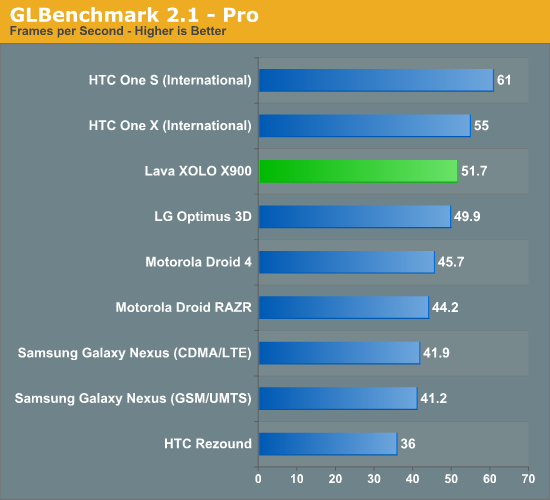
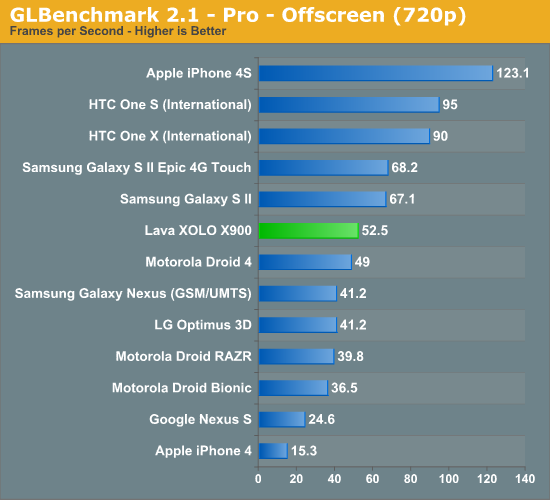
The offscreen tests give the Medfield based X900 a 25% advantage over the Galaxy Nexus, which makes sense. The Droid 4 is closer than that, despite also using the same GPU.
Basemark ES 2.0 V1
Rightware's Basemark ES 2.0 V1 is an aging GPU test that tends to favor Qualcomm's Adreno GPUs above almost all others. The Imagination Technologies based GPUs, such as the SGX 540 used in Medfield (as well as NVIDIA's Tegra GPU) don't fare as well here. Intel's GPU clock advantage does show up a little bit in these tests, making it the fastest PowerVR SGX based offering here:

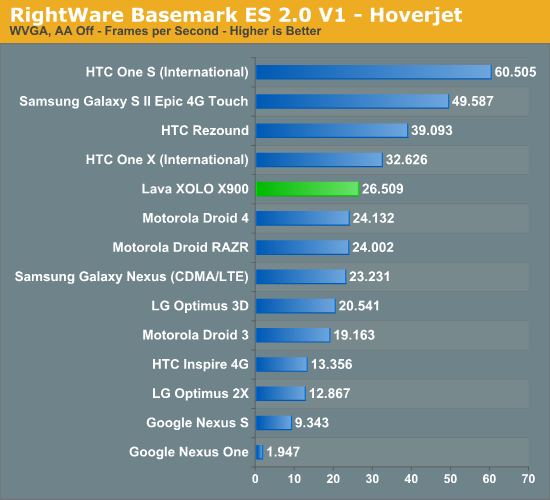










106 Comments
View All Comments
jwcalla - Wednesday, April 25, 2012 - link
Well... it's competitive. Ultimately it'll come down to who has the most desirable device. We know Apple has it's iPhone... Samsung the Galaxy S... Motorola the Droid Razr, etc. Intel would need to get in with one of those companies and be a top device to be accepted. Nobody is going to buy it just because it's Intel. (Except the fanboys of course.)dt1561 - Wednesday, April 25, 2012 - link
Looks cool but nothing extraordinary.fic2 - Wednesday, April 25, 2012 - link
Not that it matters much but does the display use Gorilla Glass?snoozemode - Wednesday, April 25, 2012 - link
Sure it's fun that Intel finally has proven that x86/Atom works in a smartphone, but the overall result is just a very bland phone that's not superior at anything really. And with a price of $420.. Why would anyone buy this?A5 - Wednesday, April 25, 2012 - link
That's $420 with no contract. Considering the average carrier subsidy is $300-$400, this is a firmly mid-range device.fm123 - Thursday, April 26, 2012 - link
That is the price in India, which could be a completely different situation than other countries.sonicmerlin - Wednesday, April 25, 2012 - link
So given the nature of x86, can we self-install other compatible operating systems such as an x86 port of MeeGo? I'm *very* interested in using MeeGo outside of the N9. What about the x86 ICS image that Google makes available on its own website? Are there any customization or tweaking requirements, or can we install any new OS the same way we would install Linux or Windows on typical x86 hardware?That would be the ultimate advantage of an x86 phone or tablet, no?
Finally, the battery tests here don't discuss standby battery life. That's always been an issue with Android, and is why every other OS seems to have much longer battery life than Android. We don't use our smartphones the way these battery torture tests suggest we do. Could you please download an app like Battery Monitor Widget and indicate how many mA are being used during standby?
dcollins - Wednesday, April 25, 2012 - link
Installing a new OS requires supported drivers. MeeGo could be installed in theory if you ported the necessary drivers from Android. They are both Linux based, so this is theoretically possible, but it will require a lot of hacking and technical expertise. The Windows driver model is totally different so you would have to reverse engineer drivers from scratch. That's not going to happen.This fight is not about x86 versus ARM as ISAs. It's about Intel versus ARM licensees: who can develop a faster, lower power chip? If Intel does their job well, the ISA shouldn't matter to the end user.
sonicmerlin - Thursday, April 26, 2012 - link
I think you misunderstand. MeeGo already provides support for x86. Technically it's now "Tizen", but regardless it's been developed with both ARM and x86 in mind. My main question is whether we can self-install an x86 port of MeeGo (or Tizen) onto this phone?fteoath64 - Saturday, April 28, 2012 - link
¨This fight is not about x86 versus ARM as ISAs. It's about Intel versus ARM licensees¨It blows down to just that!. The cost efficiency of ARM chips will just kill any chance of Intel getting into this market. Just look at a completely built Android handset made in china with retina display for $119. A retailer selling it for $160-199 will made heaps, if billions of units are involved. All licenses of chips and Android are legit. Not copycat stuff. Genuine Cortex A9 licenses.
It comes at a time when having 4-5 suppliers of ARM chips have made the market very resilient, something a single supplier can never do. So I say to Intel again, get an ARM license and play this game the right way. You can innovate very nicely with competition, and you really need that competition to keep your edge.